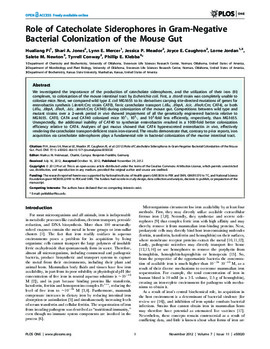| dc.contributor.author | Hualiang Pi | en_US |
| dc.contributor.author | Shari A. Jones | en_US |
| dc.contributor.author | Lynn E. Mercer | en_US |
| dc.contributor.author | Jessica P. Meador | en_US |
| dc.contributor.author | Joyce E. Caughron | en_US |
| dc.contributor.author | Lorne Jordan | en_US |
| dc.contributor.author | Salete M. Newton | en_US |
| dc.contributor.author | Tyrrell Conway | en_US |
| dc.contributor.author | Phillip E. Klebba | en_US |
| dc.date.accessioned | 2015-01-23T17:17:41Z | |
| dc.date.accessioned | 2016-03-30T15:35:39Z | |
| dc.date.available | 2015-01-23T17:17:41Z | |
| dc.date.available | 2016-03-30T15:35:39Z | |
| dc.date.issued | 2012-11-29 | en_US |
| dc.identifier.citation | Pi H, Jones SA, Mercer LE, Meador JP, Caughron JE, et al. (2012) Role of Catecholate Siderophores in Gram-Negative Bacterial Colonization of the Mouse Gut. PLoS ONE 7(11): e50020. doi:10.1371/journal.pone.0050020 | en_US |
| dc.identifier.uri | https://hdl.handle.net/11244/14082 | |
| dc.description | | en_US |
| dc.description | Conceived and designed the experiments: PEK SMN TC. Performed the experiments: HP SAJ LEM JPM JEC LJ SMN PEK. Analyzed the data: HP SAJ LEM JPM JEC LJ SMN TC PEK. Contributed reagents/materials/analysis tools: PEK TC. Wrote the paper: SMN PEK TC. | en_US |
| dc.description.abstract | We investigated the importance of the production of catecholate siderophores, and the utilization of their iron (III) complexes, to colonization of the mouse intestinal tract by Escherichia coli. First, a ΔtonB strain was completely unable to colonize mice. Next, we compared wild type E. coli MG1655 to its derivatives carrying site-directed mutations of genes for enterobactin synthesis (ΔentA::Cm; strain CAT0), ferric catecholate transport (Δfiu, ΔfepA, Δcir, ΔfecA::Cm; CAT4), or both (Δfiu, ΔfepA, ΔfecA, Δcir, ΔentA::Cm; CAT40) during colonization of the mouse gut. Competitions between wild type and mutant strains over a 2-week period in vivo showed impairment of all the genetically engineered bacteria relative to MG1655. CAT0, CAT4 and CAT40 colonized mice 101-, 105-, and 102-fold less efficiently, respectively, than MG1655. Unexpectedly, the additional inability of CAT40 to synthesize enterobactin resulted in a 1000-fold better colonization efficiency relative to CAT4. Analyses of gut mucus showed that CAT4 hyperexcreted enterobactin in vivo, effectively rendering the catecholate transport-deficient strain iron-starved. The results demonstrate that, contrary to prior reports, iron acquisition via catecholate siderophores plays a fundamental role in bacterial colonization of the murine intestinal tract. | en_US |
| dc.language.iso | en_US | en_US |
| dc.publisher | PLos One | en_US |
| dc.relation.ispartofseries | PLoS ONE 7(11):e50020 | en_US |
| dc.relation.uri | http://www.plosone.org/article/info%3Adoi%2F10.1371%2Fjournal.pone.0050020 | en_US |
| dc.rights | Attribution 3.0 United States | en_US |
| dc.rights.uri | https://creativecommons.org/licenses/by/3.0/us/ | en_US |
| dc.subject | PLOS | en_US |
| dc.subject | Public Library of Science | en_US |
| dc.subject | Open Access | en_US |
| dc.subject | Open-Access | en_US |
| dc.subject | Science | en_US |
| dc.subject | Medicine | en_US |
| dc.subject | Biology | en_US |
| dc.subject | Research | en_US |
| dc.subject | Peer-review | en_US |
| dc.subject | Inclusive | en_US |
| dc.subject | Interdisciplinary | en_US |
| dc.subject | Ante-disciplinary | en_US |
| dc.subject | Physics | en_US |
| dc.subject | Chemistry | en_US |
| dc.subject | Engineering | en_US |
| dc.title | Role of Catecholate Siderophores in Gram-Negative Bacterial Colonization of the Mouse Gut | en_US |
| dc.type | Research Article | en_US |
| dc.description.peerreview | Yes | en_US |
| dc.description.peerreviewnotes | http://www.plosone.org/static/editorial#peer | en_US |
| dc.identifier.doi | 10.1371/journal.pone.0050020 | en_US |
| dc.rights.requestable | false | en_US |

